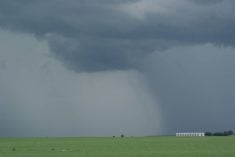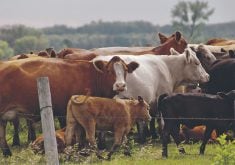Sylvia Martinetz owns a very deliberate sheep. That’s not an adjective one normally associates with animals of the ovine persuasion, but this particular ewe simply doesn’t rush into things. Especially motherhood.
Three years ago, Martinetz, who farms near Wildwood, Alta., wrote to the Producer with the story of a ewe that had one lamb on Friday and a set of twins on the following Friday. A veterinarian was able to explain the biology of the event but it was nevertheless a rare thing for a ewe to land one lamb and then bide its time for a week before introducing the possibility of sibling rivalry.
Read Also

Farmer ownership cannot be seen as a guarantee for success
It’s a powerful movement when people band together to form co-ops and credit unions, but member ownership is no guarantee of success.
Apparently the ewe rather liked the division of labour, because she did the same thing this year. On Feb. 28, she had one lamb. On March 2, she added a set of twins.
“After she had the first lamb, I knew she’d have more inside (because of her size) so I watched her closely,” Martinetz wrote.
We thank her for this recent update, and thank ewe too.
On another front is another update. A few weeks ago we reported on freelance writer Brad Bird’s project to walk the length of Manitoba this winter. He’s driven by the desire to raise money for the heart and stroke foundation and also to encourage people to support Manitoba’s cattle industry as it battles the BSE crisis.
Bird called last week with good news and bad news from his walk, which had, as of March 15, extended over 900 kilometres and 46 days.
The good news: he has raised about $5,000 for the Heart and Stroke Foundation. The bad news: he contracted pneumonia and had to spend several days in the Norway House hospital.
The illness has put him behind schedule so Bird now hopes to reach Churchill by the end of April.
One final update: On May 20, 2004, the Producer compiled a special section called Black Day in May: BSE One Year Later.
Calgary-based analyst-reporter Barbara Duckworth was the lead hand on the project, with other members of the Producer editorial team also providing material on the many facets of the BSE crisis.
This package has earned Duckworth a first place award in the special projects category in an annual awards program organized by the North American Agricultural Journalists.
As well, the NAAJ recognized Winnipeg-based editor-reporter Ed White with a second place award in the series category, for his extensive coverage gained on a fact-finding mission to Brazil in early 2004. White’s stories and photographs provided our readers with insight into Brazil’s agricultural stengths.















